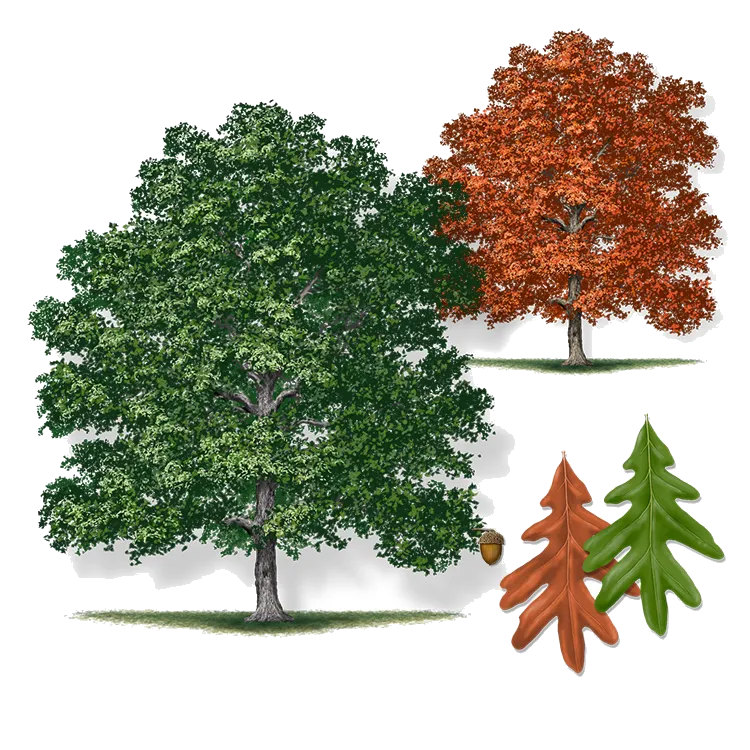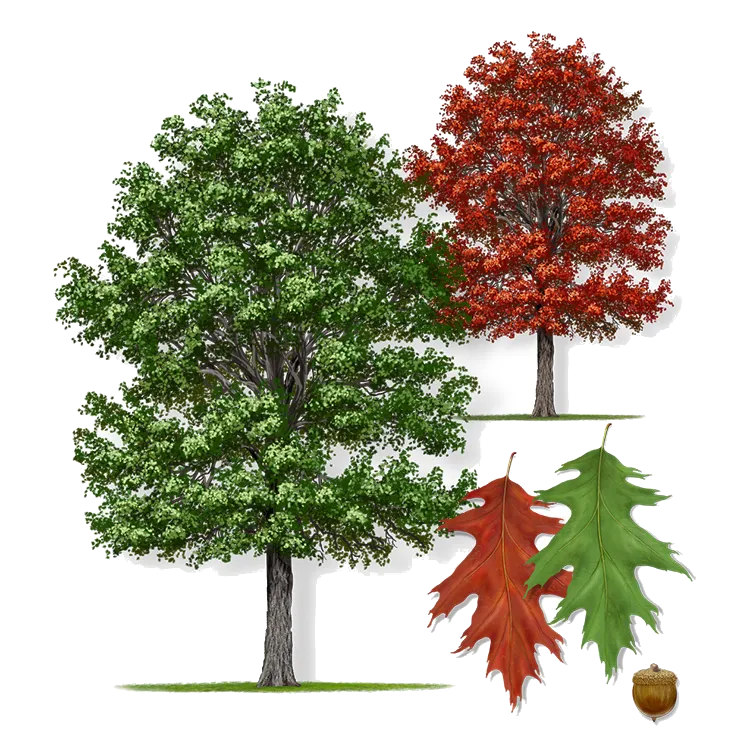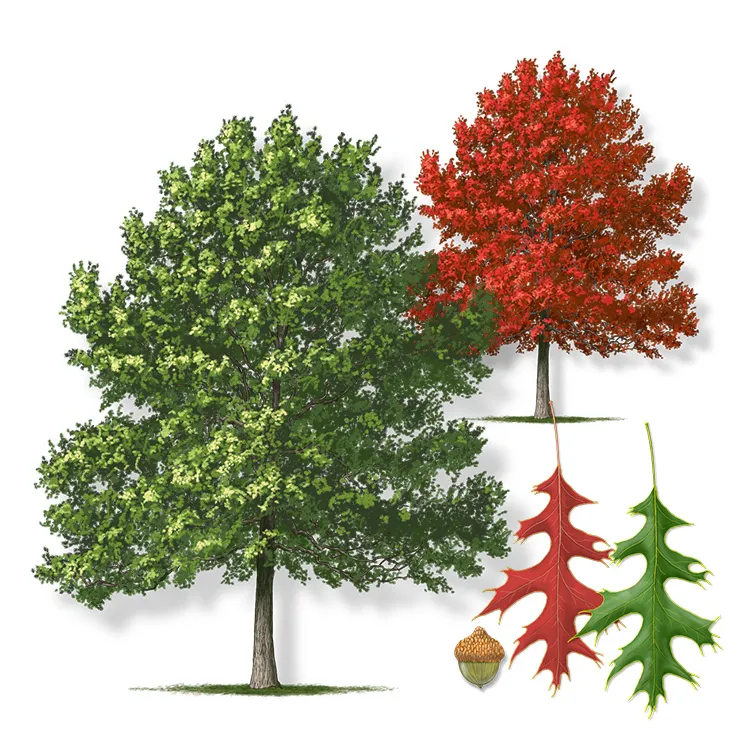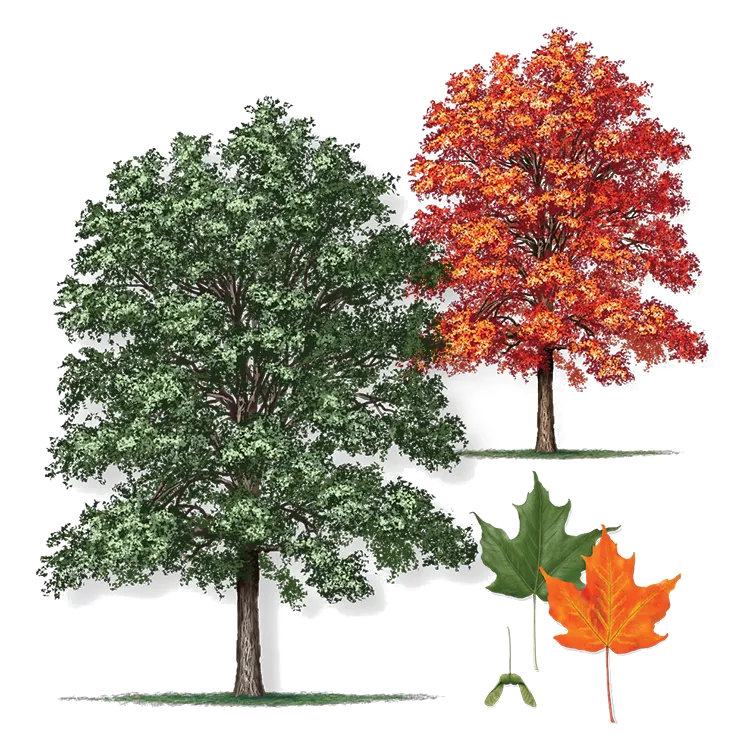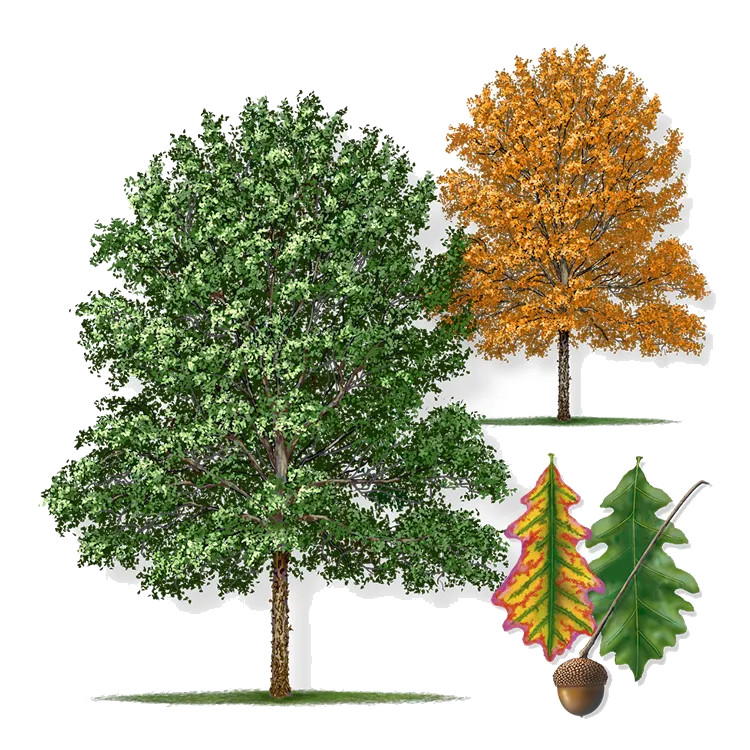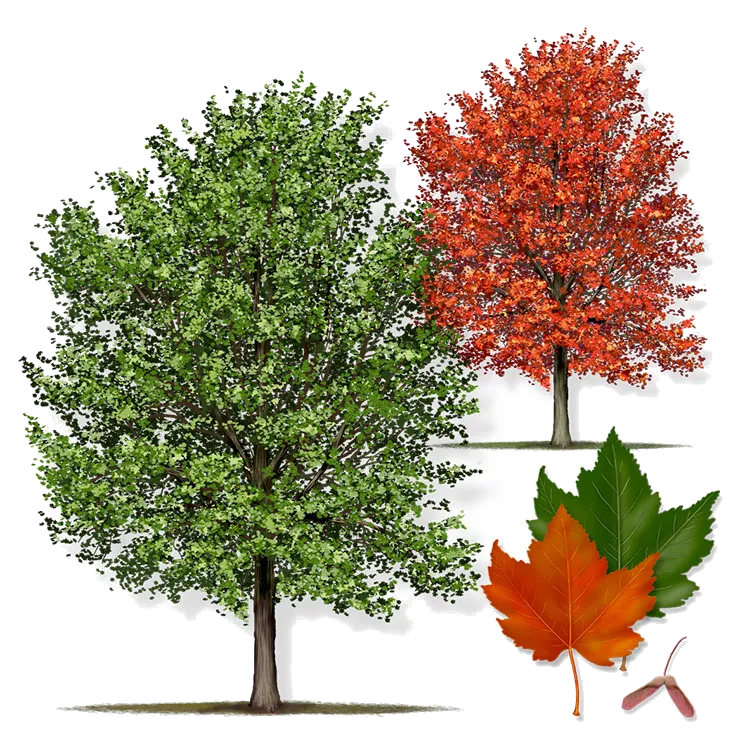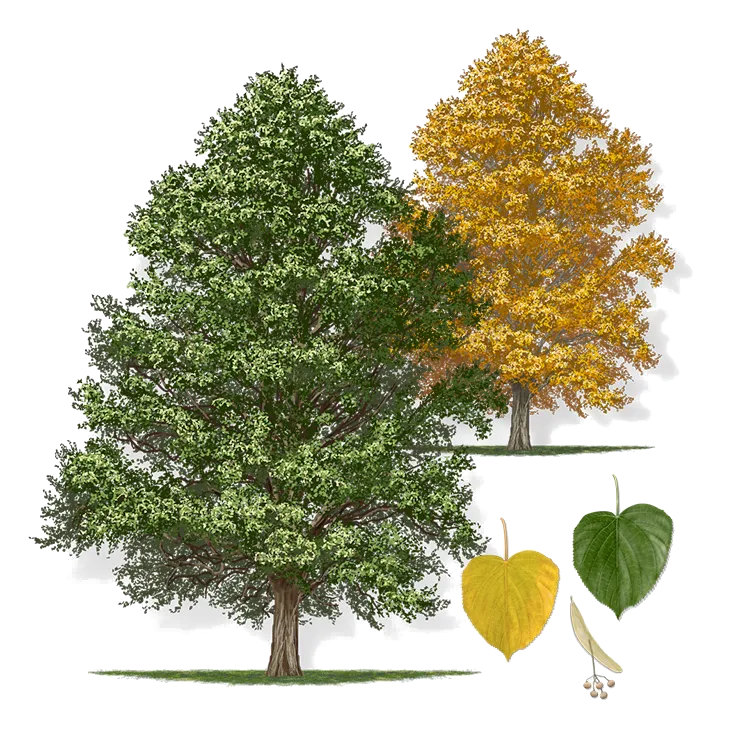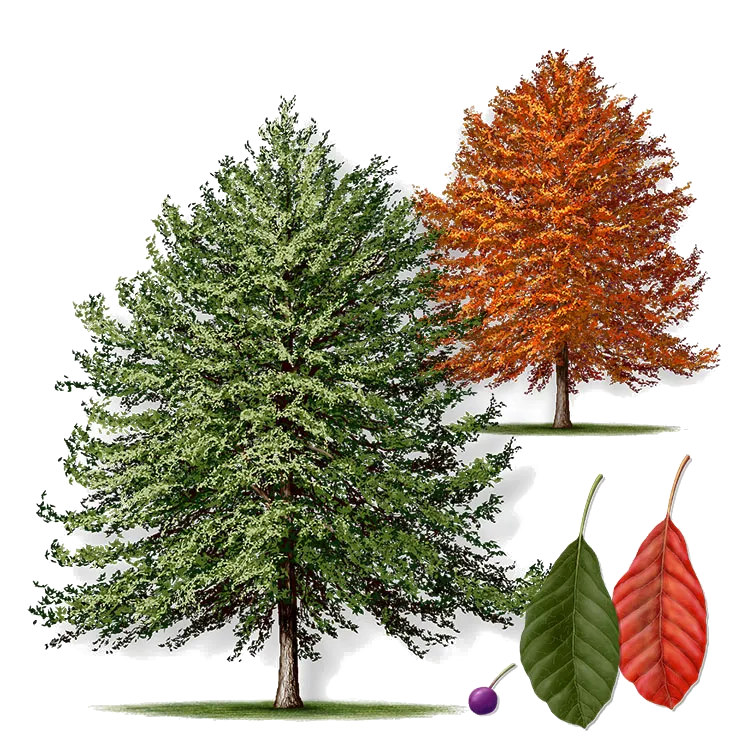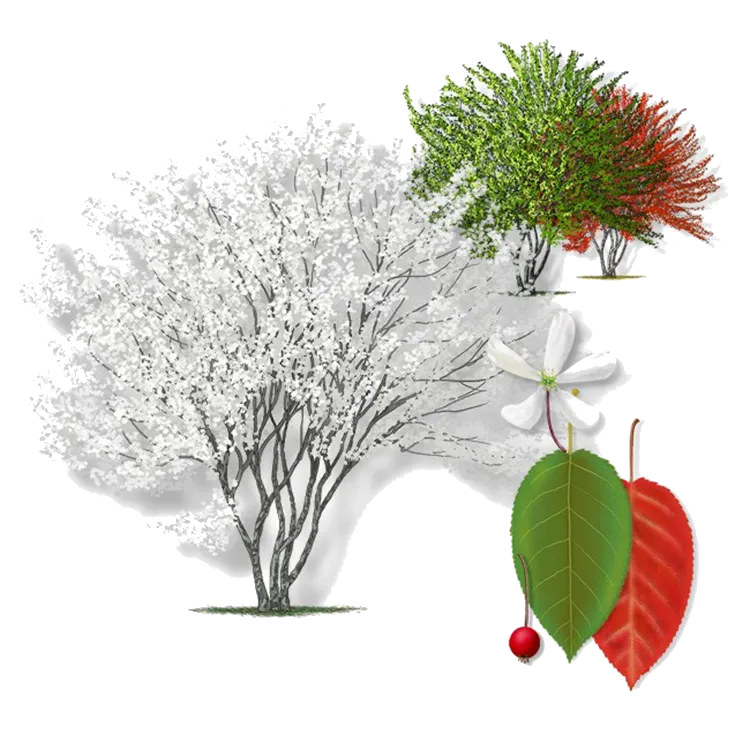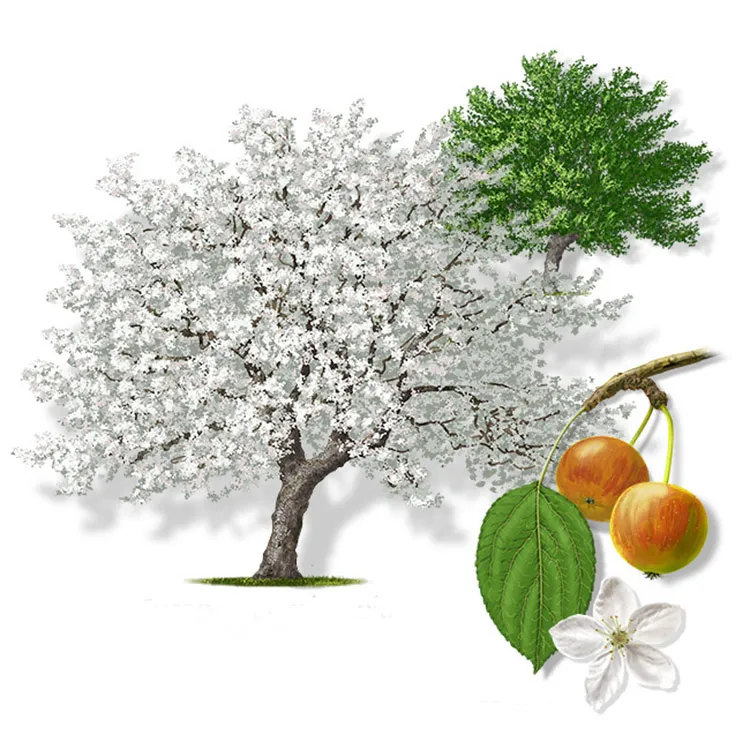What’s the best tree for your yard?
These trees are all well suited to thrive in Springville’s climate and to massively enrich the local ecosystem. They feature high biocentric scores and they are natural contributors to the environment by providing food and habitat for wildlife.
All of these trees are native to New York.
Request a tree or keep scrolling for a look at the types of trees that we’d like to plant on your property.
Images are included to give you a general idea of the species. Slight variations (cultivars) of the displayed tree may be planted instead.
Tree illustrations (©️Robert O’Brien)
Jumbo trees 👇
These trees need a large property with plenty of space to spread their expansive branches. They cannot be placed near power lines and their root systems can press foundation walls if planted too close to structures.
White oak
Quercus alba
HEIGHT: 100′ | SPREAD: 80′
ROUNDED
Ever heard the saying “As strong as an oak”? That’s this tree, an awe-inspiring symbol of strength, resilience, and natural beauty. These trees are generational landmarks, towering overhead for centuries.
Oaks are a keystone species that provide vital supportive resources that help define and protect our entire ecosystem. Without oak trees, the local environment would be dramatically different.
The grand canopies of white oaks are nature magnets for wildlife, like a fully stocked farmers market loaded with organic everything.
These trees are survivors and can thrive in all but the wettest and heaviest of soils.
If you have the space, there is no better tree to plant.
Large trees 👇
These trees need adequate space but can usually find room to grow on a typical residential property in Springville. They must be planted far enough away from power lines but have a more manageable spread.
Red Oak
Quercus rubra
HEIGHT: 75′ | SPREAD: 60′
PYRAMIDAL
The red oak is a big, beautiful shade tree that lives up to its name, transforming from green to a vibrant red (and sometimes yellow) every fall. This tree sports a rounded, open crown of glossy foliage.
Red oaks grow a little faster than white oaks but share many of the same attributes, including a long life. This tree typically lives for 200 years so planting one is an investment for future generations.
Red Oaks grow best in full sunshine with plenty of room.
Scarlet oak
Quercus coccinea
HEIGHT: 70′ | SPREAD: 40′
PYRAMIDAL
If you’ve witnessed a scarlet at its peak, you’ll want one. Fall color is an understatement — these trees will take your breath away with their deep, rich fall color.
Winter can bleak around these parts but scarlet oaks are one of the few species whose leaves (especially on young trees) remain on the tree throughout much of the winter.
This tree loves light and is perfect for creating a large shaded oasis in the center of hot, dry landscapes with blinding bright sunshine from the southern exposure.
The tree is very tough and can handle variations in soil. Because of this hardiness (and beautiful foliage) many sources agree that a scarlet is the choice oak for urban plantings.
A favorite of bluejays in the fall, you’ll see them hiding acorns for future use — the ones they forget will grow into the next generation of scarlet oaks.
Sugar maple
Acer saccharum
HEIGHT: 75′ | SPREAD: 50′
ROUNDED-OVAL
This is a classic, beloved shade tree that provides the iconic colors of the northeast autumn with spectacular fall foliage filled with vivid reds, oranges, and yellow colors. Every spring these trees are tapped as the primary source of maple syrup. It’s no wonder that the sugar maple is the official tree of New York. (And Vermont, West Virginia, and Wisconsin).
Sugar maples are slow-growers but can live a few hundred years when planted in the right conditions. They do well in cooler locations away from the heat of roads or driveways, and they can thrive in the shade — they’ll find their way to the sun.
Sugar maples are irrigation factories. They have deeper roots than most maples and engage in hydraulic lift, drawing water from lower soil layers and exuding that water into upper, drier ground. This not only benefits the tree itself, but also many other plants growing around it.
Swamp white oak
Quercus bicolor
HEIGHT: 60′ | SPREAD: 40′
ROUNDED
Heavy wet soils? A swamp white will figure it out, even if it takes a few hundred years.
A long-living, massive provider of biodiversity, swamp white oaks form a broad, round canopy a cast a dense shade below.
This tree is extremely tolerant of low-oxygen soil conditions making it equally great in hot sunny yards or in boggy, poorly drained soils. Its leaves are a deep green color, and in the autumn, they turn a bright yellow (occasionally brown or red). The swamp white oak’s bark is deeply ridged and furrowed with character.
Like all oaks, swamp white oaks support a myriad of wildlife. Deer browse the twigs and foliage. Acorns draw squirrels, chipmunks, bluejays, pileated woodpeckers (the big red ones), turkeys, and literally hundreds of other wildlife species.
Red maple
Acer rubrum
HEIGHT: 75′ | SPREAD: 50′
ROUNDED-OVAL
Red maple’s ability to thrive in a wide range of wet to dry conditions surpasses the tolerance capabilities of perhaps all other species. Red maple is one of the most abundant and widespread of eastern North American deciduous trees.
This fast-growing, hardy tree grows in most conditions, and its early flowers are important to pollinators. Grab a bucket in the spring — red maples can be used to harvest syrup (even if they’re a little less sweet than their sugar maple cousins).
Like all maples, these trees produce small, gravity-defying seeds — samaras — known affectionately to children everywhere as “helicopters”. This is nature’s way of slowing their descent, giving the wind a chance to further their spread.
Medium trees 👇
These trees are often faster growing and easier to place on smaller properties and closer to homes.
American linden
Tilia americana
HEIGHT: 75′ | SPREAD: 40′
PYRAMIDAL
The basswood, or American linden, is well adapted for large backyards and open spaces. This is a fast-growing, hardy tree, resistant to various soils and sunlight exposures.
Basswood trees are a hub of activity for wildlife. In early summer, they produce clusters of delicate, pale yellow, or cream-colored flowers that fill the air with a sweet, intoxicating scent that is irresistable to pollinators — and a vital source of nectar for hardworking honeybees. The seeds, buds, and twigs are eaten by a variety of wildlife including chipmunks, squirrels, deer, ducks, and woodpeckers.
In addition to their stunning blossoms, Basswood trees offer a serene and peaceful environment in your yard. Their large, heart-shaped, papery leaves create a cool, shady canopy during the hot summer months, defining the perfect spot for relaxation and outdoor gatherings.
Tupelo
Nyssa sylvatica
HEIGHT: 30′ | SPREAD: 20′
PYRAMIDAL
Picture Springville, far in the future, in the year 2524. Robots streak across the skies in hydro-powered jetpacks, the Bills have just won their 35th Super Bowl, and right there, on what used to be your front lawn, is a very old Tupelo tree that you planted in 2024. You read that right — Tupelo trees can live for 500 years. That’s half a millenium.
While we can’t promise yours will live quite that long, we can offer a few certainties.
The Tupelo tree is highly adaptable and grows about a foot each year in nearly all conditions.
These trees are like a magnet for wildlife. Their small, dark berries are a favorite snack for birds, including woodpeckers, robins, and warblers. If you’re a bird-watching enthusiast, you’ll have a front-row seat to a lively avian spectacle. The flowers are valuable to bees and other pollinators. As the tree ages, its distinctive bark can resemble alligator hide and hollow trunks provide nesting and refuge areas for many animals.
In spring and summer, a Tupelo’s lush green foliage provides a canopy of shade for your yard, creating a cool, peaceful retreat from the summer sun. And the autumn display is breathtaking — the leaves turn brilliant shades of red, orange, and deep purple.
Small trees 👇
These trees work almost anywhere and are usually safe under power lines and much closer to structures. You’ll often see them as ornamental additions to landscaping close to the home. They are all early bloomers each spring.
Serviceberry
Amelanchier
HEIGHT: 20′ | SPREAD: 20′
OVAL
Small, manageable under power lines, and beautiful, serviceberry trees deliver fall colors, spring flowers, and edible berries.
These moderate-size trees are easy to grow and give a yard three seasons of color, producing fragrant white flowers in early spring, green foliage and berries in the summer, and blazing orange, yellow, and red leaves in the fall. They grow slowly, seldom need pruning and don’t have invasive roots, so they’re a good choice for small yards where they’ll be close to driveways, sheds and water mains. They work in a variety of soils and can grow with as little as 4 hours of sunlight a day.
Serviceberries are the first to bloom in spring, offering almost year round visual interest. Even in winter, their unique, silvery-gray bark adds a touch of elegance to the landscape.
Serviceberries are like tiny blueberries, morphing from green to red to nearly black when fully ripe. They are delicious, very sweet to taste, but good luck getting them before the birds.
The trees also attract bees, butterflies, and other pollinators, making them an ideal choice for a wildlife or pollinator garden, or to foster a yard with a healthy little eco-system.
Hawthorn
Crataegus
HEIGHT: 20′ | SPREAD: 25′
OVAL
These trees give you something to look at all year long.
Hawthorns bloom in the spring with a multitude of delicate white flowers which are followed by small red fruits that ripen in September and usually persist on the tree well into winter.
During summer, lush green leaves provide a dense haven for wildlife, and in autumn, they transform into a fiery spectacle of red, orange, and deep purple. The intricate, thorny branches of a Hawthorn in winter create a unique and captivating silhouette.
It’s fairly easy to find a place for a hawthorn — these trees are great under or near power lines and they love plenty of sun.
They’re also a hub for wildlife. Birds, bees, and butterflies absolutely adore them. The vibrant blossoms provide nectar for pollinators, while their fruits are a buffet for birds.
Hawthorns have been celebrated in various cultures for centuries. In Celtic folklore, they were seen as magical trees, and they often marked the boundaries of ancient forests. Connect with a rich cultural heritage (and improve the local biodiversity) just by planting one in your yard.
Crabapple
Malus
HEIGHT: 15′ | SPREAD: 20′
UPRIGHT OVAL
Sometimes mistakenly called cherries because of their profuse spring flowers, lustrous foliage, and colorful fruits on long stems, crabapples are a beloved landscaping staple.
In spring, crabapples burst into a profusion of fragrant blossoms, ranging from snow-white to deep pink, creating a display straight out of a fairy tale. Summer’s canopy of leaves provides cool shade, a vibrant backdrop, and ornamental fruits that persist into the winter in shades of red or orange.
Birds can’t resist crabapples. Add orioles, bluebirds and cedar waxwings to your guestbook. And the fruits attract butterflies and other pollinators.
These trees are known for their resilience and relatively low maintenance. They can adapt to various soil types and are generally hardy. Plus, they’re less prone to diseases compared to other fruit trees, so you won’t need to worry too much about their health.
While most crabapples are smaller than regular apples, they are still edible and can be used in jams, jellies, or as decorative additions to salads. Imagine harvesting your own crop of tiny, tasty treasures, and leaving the rest as a contribution to the wildlife around you.
Flowering dogwood
Cornus florida
HEIGHT: 20′ | SPREAD: 20′
OVAL
Slow-growing but long-lasting, the flowering dogwood is sometimes considered the most spectacular of the native, flowering trees.
This multi-trunked ornamental tree can help transform your garden into a heavyweight environmental contributor. Your dogwood will be a buzzing, fluttering hotspot of activity and adds a colorful pop to your outdoor space.
Dogwoods are among the first trees to bloom each spring when they unfurl their four-petaled blossoms in shades of pink and white. Their canopy transitions into a deep green for the summer before exploding into fiery shades of red and orange in the fall. Distinctive branches can give you something other than snow to look at in the Springville winters.
Their nectar-rich blossoms attract butterflies, bees, and other pollinators and the tree’s bright red berries are a gourmet treat for over 75 species of birds.
Flowering Dogwoods are relatively low-maintenance trees, making them an excellent choice for gardeners of all levels. They prefer well-drained (but not dry) soil and appreciate some afternoon shade, which can make caring for them a breeze.

